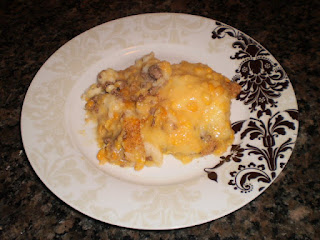In Québec, every family has their recipe for shepherd's pie (commonly known here as pâté chinois - more on that in a minute), and they will each insist that their version is the real shepherd's pie. In that aspect, people here are very much like Italians, who all claim to make the original (and the best) minestrone or bolognese or pizza, or whatever. Every version is probably delicious, but family traditions are big deals in Italy, as they tend to be here in Québec.
It's no wonder that this dish became popular here after the massive waves of Irish immigrants settled in Canada after the potato famine, as it's very similar to Irish cottage pie. But it is called pâté chinois because during the railway construction in the late 19th century, English bosses taught their crew's cooks how to prepare it for the workers, who were predominantly Chinese. Those workers brought the recipe back to the cities and villages, and tada! It became known as Chinese pie.
Nothing says "homey winter food" like a steaming plate of shepherd's pie. It's one of those staples of Québec cuisine that makes winter a little easier to deal with. Hearty, filling and comforting; those recipes are priceless when the harsh January weather is around the corner (like today's -31).
This recipe is the bare-bones, uber-simple comfort food dish that my mom makes. We are a weird family, so we stray from tradition by putting the corn on top of the potatoes. Crazy, huh? It serves 4 to 6.
2 1/2 pounds Russet potatoes, peeled and coarsely chopped
1/2 cup milk
2 to 3 tablespoons butter
1 pound ground beef (or a mix of ground beef, pork and veal)
2 cloves garlic, chopped
1 yellow onion, finely chopped
1 (24 ounce) can creamed corn
Olive oil
Sea salt and ground pepper
Bread crumbs (optional)
Place the potato chunks in a large pot and cover with water. Boil until the potatoes are easily pierced with a fork. Drain in a colander and put back in the pot along with the milk and butter. Mash until creamy and set aside. Preheat the oven to 375 degrees. Preheat the olive oil a frying pan over medium heat. Add garlic and onions and sauté until the onions are soft and golden. Add the ground meat, season with salt and pepper, and cook for 7 to 10 minutes, until crumbling. In a Pyrex or casserole dish, put the meat and onion mixture in a layer. Cover with the mashed potatoes. Spread well to cover the meat. Add the creamed corn as the top layer. Sprinkle with bread crumbs, if using. Place in the middle of the oven for 30 to 40 minutes, until the top layer is golden and bubbling. Serve with ketchup, if you must.
This is the way my mom taught me to make it, but it's easily spiced up. Here are some ways to shake it up:
- substitute one pound of the Russet potatoes for sweet potatoes
- add another clove of garlic and use ground lamb instead of beef (technically, it is shepherd's pie only if mutton meat is involved - the proper name for this dish with beef is "cottage pie", not that anyone cares...)
- add a small can of corn nibblets to the creamed corn
- sprinkle with grated aged cheddar or Gruyère before putting the dish in the oven
Shepherd's pie can easily be frozen and re-heated later. It's surprisingly delicious reheated in the frying pan. Now, I know some other shepherd's pie recipe make a very firm casserole that you can artfully cut out and get a perfectly layered piece in your plate. Mine isn't like that at all, as you can see.
But the messy look has it's advantages! I prefer to generously sprinkle my plate with freshly ground pepper and vigorously mix the whole thing so that I can have a bit of every ingredient on my fork in every bite. If you want a nice, more photogenic shepherd's pie, I am told that the key is to bake it at a lower temperature, for a longer period of time.
But the messy look has it's advantages! I prefer to generously sprinkle my plate with freshly ground pepper and vigorously mix the whole thing so that I can have a bit of every ingredient on my fork in every bite. If you want a nice, more photogenic shepherd's pie, I am told that the key is to bake it at a lower temperature, for a longer period of time.


Huh, I always wondered why it was called that in French.
ReplyDeleteStealing a whole bunch of these recipes. When I have time to cook again, I'll be starting with these!